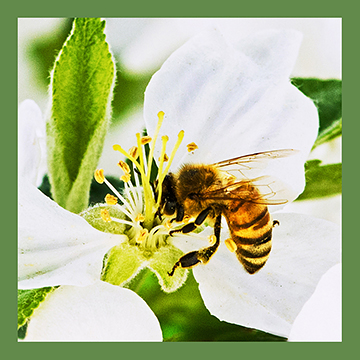Honey bees, art and addressing dualities in human affairs
COFFEE WITH WARREN, with Warren Harbeck
Cochrane Eagle, May 12, 2016

Ah, the bee: symbol of honey and good crops to come, but also of pain for those who get stung.
Photo by Warren Harbeck
Last Friday a bee visited the blossoms on our backyard apple tree, rewarding the tree with the promise of fruit – and rewarding me with the perfect photo op for the Mother’s Day card I made for my wife Mary Anna.
And of course, what could I write on the card next to the photo? Why, “For my Honey,” of course!
But experience has alerted me to another gift bees can give to the unwary: a nasty sting! Yes, both pain and pleasure in one amazing creature.
This duality is no stranger to our beekeeping coffee companion Stella Constance, Calgary writer/dramatist and frequent visitor to Cochrane. She sees in bees an opportunity to look outside our culture’s fixation on individualism to the wellbeing of the wider community.
Stella took up apiculture, she says, “to return the full bloom of plant life to my community and the mental wellness that goes along with a more natural and beautiful environment that only bees can bring.”
She recently published an article on societal wisdom to be learned from honey bees and other creatures. In The Duality of Humans she says:
“The duality state of the social animal is split into two interdependent states comprising of: individuality and the collective (with which the individual identifies and connects). A healthy balance of the two states is needed for the individual to thrive in any environment.” (For entire article, click here.)
Stella’s views on a healthy balance between individuality and the collective got me thinking further about Jim Hillson’s letter I ran in last week’s column. You’ll recall that Jim argued for the importance of the artist to depict not only the “pretty” sides of life, but the ugly sides as well, an emphasis Russian writer Alexander Solzhenitsyn also argues for.
This dual responsibility of the artist was not missed by many of our readers.
From Wales, former Bow valley resident Eileen Freels Peakman writes: “Photographers and artists have often shown us the beauty and dignity of people in desperate circumstances” – shown us the amazing indomitability of the human spirit. And what better evidence that life itself can be seen as a work of art than the outpouring of compassion amidst the horrors of the Fort McMurray wildfire?
Antiquities scholar Kathleen Adamson distinguishes the role of the photographer from that of the artist. “A photograph … can probably capture much – but not all – of the subject’s beauty probably better than an artist can,” she says. What the artist contributes is insight and interpretation.
“One of my absolute faves is the Belgian James Ensor, who did a famous painting of Brussels, which, on first glance appeared to just be a colourful and rather gay (old sense) crowd of people in a city street, but on closer looking, you will recoil to see the twisted, grimacing faces of cruelty, greed, lust and stupidity. He is not just showing that side of man; he is, by making the scene so ‘cheerful’ at first gaze, telling you, ‘This is what lies beneath the surface of society; look harder folks!’”
Nevertheless, it’s important that we not lose sight of the beautiful side of life, says Cochrane coffee companion Dan Miller, a self-described “armchair philosopher.” I’ll close with an inspiring recommendation he sent us.
Lamenting the recent emergence of the “cult of ugliness” in art, Dan draws our attention to the video, Why Beauty Matters, by philosopher Roger Scruton, viewable by clicking here.
Thank you, readers, for your wisdom on balance in life’s dualities.
© 2016 Warren Harbeck
JoinMe@coffeewithwarren.com